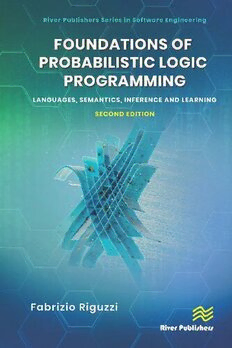
Foundations of Probabilistic Logic Programming: Languages, Semantics, Inference and Learning PDF
548 Pages·2023·41.1 MB·
Most books are stored in the elastic cloud where traffic is expensive. For this reason, we have a limit on daily download.
Preview Foundations of Probabilistic Logic Programming: Languages, Semantics, Inference and Learning
Description:
The computational foundations of Artificial Intelligence (AI) are supported by two comer stones: logics and Machine Leaming. Computationallogic has found its realization in a number of frameworks for logic-based approaches to knowledge representation and automated reasoning, such as Logic Program ming, Answer Set Programming, Constraint Logic Programming, Description Logics, and Temporal Logics. Machine Leaming, and its recent evolution to Deep Leaming, has a huge number of applications in video surveillance, social media services, Big Data analysis, weather predictions, spam filtering, online customer support, etc.Since its birth, the field of Probabilistic Logic Programming has seen a steady increase of activity, with many proposals for languages and algorithms for inference and learning.This book aims at providing an overview of the field with a special emphasis on languages under the Distribution Semantics, one of the most influential approaches. The book presents the main ideas for semantics, inference, and learning and highlights connections between the methods.Many examples of the book include a link to a page of the web application where the code can be run online.This 2nd edition aims at reporting the most exciting novelties in the field since the publication of the 1st edition. The semantics for hybrid programs with function symbols was placed on a sound footing. Probabilistic Answer Set Programming gained a lot of interest together with the studies on the complexity of inference. Algorithms for solving the MPE and MAP tasks are now available. Inference for hybrid programs has changed dramatically with the introduction of Weighted Model Integration.With respect to learning, the first approaches for neuro-symbolic integration have appeared together with algorithms for learning the structure for hybrid programs.Moreover, given the cost of learning PLPs, various works proposed language restrictions to speed up learning and improve its scaling.The intended audience of the book are researchers in Computer Science and AI that want to getan overview of PLP. However, it can also be used by students, especially graduate, to get acquainted with the topic, and by practitioners that would like to get more details on the inner workings of methods.
See more
The list of books you might like
Most books are stored in the elastic cloud where traffic is expensive. For this reason, we have a limit on daily download.
